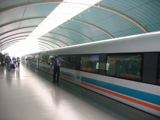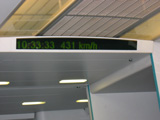



The MAGLEV train
A super high-speed transport system with a non-adhesive drive
system that is independent of wheel-and-rail frictional forces has been a long-standing
dream of railway engineers. Maglev, a combination of superconducting magnets and
linear motor technology, realizes super high-speed running, safety, reliability,
low environmental impact and minimum maintenance.
A magnetic levitation
train or maglev is a kind of train which travels suspended in the air
on a rail thanks to the magnetic repulsion.
The magnetic repulsion and attraction
are used also as means of transportation. As the train is suspended on the air
has not a real contact with the rail and consequently the only force that is opposed
to the movement is the friction with the air. Because of this the maglev train
can travel at a very high speed with a reasonable consumption of energy and an
acceptable level of noise (some systems can travel at a speed of 650 Km/h, a speed
which can be compared to the one of a plane). Although the maglev speed could
allow to this kind of train to compete with the air transportation even in the
long distances, the high cost for the achievement of the infrastructures has limited
at present its use in very frequented short distances.
The only today's commercial
practical application is in Shanghai where a maglev line links the town with Pudong
Airport. The standard price for a one way trip is 50 RMB (Renmimbi). If you show
the plane ticket at the counter the price is reduced to 40 RMB. The price is reasonable
as a taxi costs between 80 to 100 RMB for the same distance. By bus it costs 18
RMB, but it takes 40 minutes. The maglev train takes only 7' 21" to cover the
distance of 30 Km. at the highest speed of 431 Km/h, and an average speed of 250
Km/h.
The train is active from the 29th of March 2004, and works from 8.30
a.m. to 5.30 p.m. with an interval of 20'.
The outlay for the construction
of the special line for maglev train was 50 millions US$ a kilometer, an astronomical
figure, and probably the operating life of the train will not be enough to amortize
the sum invested.
Other implementations of maglev train are at present under
consideration.
Japan and Germany are very active countries in the research
concerning maglev trains and produced different approaches to this problem. In
a project the train levitates thanks to the repulsive force of the same magnetic
pole, and moves thanks to the attractive force that develops between the opposite
poles. The train is moved by a linear engine along the route or inside the train
(or in both). The magnetic inductors of big dimensions are installed in the route
and they generate the magnetic field necessary to sustain the train and to make
it move.
Set magnets based on electromagnets or permanent magnets would be
unstable due to the theorem of Earnshaw. On the other side diamagnetic magnets
and superconductors cannot maintain a maglev stable. The current maglev systems
are stabilized by electromagnets electronically managed. These big electromagnets
are very heavy and request a big quantity of electric current.
The weight
of a big electromagnet is a very important component in a maglev project. A very
intense magnetic field is necessary to make levitate a heavy train and the conventional
research on maglev trains aims to use superconductors to realize efficient electromagnets.
The
effects of an intense magnetic field on the human body are largely unknown. For
passengers' security it could be necessary to add some screens against the magnetic
fields. The idea is simple, but the engineer design is very complex.
A new
system, perhaps cheaper of conventional systems is called inductrack.
This technology is based on non-supplied electromagnets (passive) use and on permanent
magnets. The theory is based on the use of currents produced by permanent magnets
in the electromagnets when they cross the form lines produced by permanent magnets.
This technology needs current only during the movement of the train and the necessary
quantity is proportional to the speed of it. In the prototype the permanent magnets
were mounted on the trolley horizontally for the high and vertically for the stability.
The magnet and the trolley are supplied only to give speed to the trolley. Inductrack
was originally developed to create a magnetic engine that stores energy through
the movement of the trolley. With some slight modifications to the project, the
original line, which was a closed circle, was extended to become a straight line.
Inductrack was developed by the physicist Richard Post from the Lawrence Livermore
National Laboratory.
Inductrack uses Halbach Array to stabilize. The Halbach
Arrays are a set of permanent magnets that stabilize the movement in the magnetic
force lines without the necessity of electronics; these elements increase the
magnetic field on one side cancelling the presence on the opposite side. The Halbach
Arrays were originally developed to stabilize the beam of particles accelerators.
Furthermore, they generate a magnetic field only on the side faced to the track
reducing the potential unwelcome effects suffered by the passengers.
At present,
many space agencies, including NASA, are conducting researches on maglev to develop
a cheap method of spatial thrower. Space agencies would like to develop so fast
maglev to overcome the speed of terrestrial escape. To use a maglev to accelerate
a trolley would allow to use small rockets to reach the orbit. The friction with
the air makes difficult to realize a maglev that can enter into orbit without
using rockets unless to build a launching pad on a very high mountain as the mountains
of Himalaya range.
Existing
Maglev
In Berlin
the M-Bahn Company built in the 80ies a 1,6 Km. maglev that linked three U-Bahn
stations (metro). The test with passengers traffic started in August 1989 and
the regular service in 1991. Since the passengers traffic modified after the fall
of the Berlin Wall, the line was abandoned in February 1992, dismantled and substituted
by a normal metro line.
The first commercial automatic system based on low-speed-maglev
was developed to link the international airport of Birmingham with the international
railway station of Birmingham, operating between 1984 and 1995. The track was
600 meters long and the train was suspended 15 mm. over the rails. It worked eleven
years, but the obsolescence of electronics made the system unsafe and consequently
was it subsituted by a conventional system.
Transrapid is a German company
that developed a test line in Emsland and built the first commercial high speed
line of maglev, the Shanghai Maglev Train in Shanghai, China in 2002. This line
links the Shanghai international airport, located in Pudong, with the town. The
line is 30 Km. long and the highest speed ever reached is 501 Km/h.
Japan tested
in the Yamanashi prefecture a maglev train that reached the speed of 581 Km/h.,
the highest speed ever reached on a track. The train uses superconductors magnets
and electrodynamic suspensions. On the contrary, the Transrapid uses conventional
electromagnets and electromagnetic suspensions of attractive type. The "Superconducting
Maglev Shinkansen" developed by the Central Japan Railway Co. ("JR Central") and
Kawasaki Heavy Industries is at present the fastest train in the world. If the
proposal of Chuo Shinkansen will be approved, Tokyo and Osaka will be linked by
the maglev and the track test will be part of the line.
The first commercial
system of urban maglev became effective in Japan in March 2005. This system is
formed of nine stations along a 8.9-kilometer-track of Tobu-Kyuryo line, known
also as Nagoya East Hill Line. The line has an operative beam of 75 meters and
an inclination of 6°. The linear magnetic levitation engine has a top speed of
100 Km/h. That line was used by the population to reach the Expo 2005. The train
was developed by Chubu HSST Development Corporation that cooperated also with
the test track in Nagoya. A urban maglev as the japanese one was presented in
Korea and the korean version is called Rotem.
In the USA the Federal Transit
Administration started the Urban Maglev Technology Demonstration program.
The program has the aim to project low speed maglev to be used in town and
at the beginning was considered the HSST technology. The FTA financed the General
Atomics and the California University of Pennsylvania for the development of a
new maglev generation, the Magnemotion M3 and the Maglev 2000 of
Florida, both based on superconductors EDS. Another project for a urban maglev
is the LEVX developed in the state of Washington, the Magplane developed
in Massachussets, and the project similar to the HSST system developed by the
American Maglev Technology of Florida and by the Old Dominion University
in Virginia.
The 31 of December 2000 the first high temperature superconductor
for maglev was successfully tested in the Southwest Jiaotong University,
of Chengdu, in China. The system is based on high temperature superconductors
that are made levitate on permanent magnets. The load was 530 kilos and the distance
between the magnets was 20 millimeters. The system used liquid nitrogen, a very
cheap refrigerant for superconductors.
The first patent for the train magnetic
levitation with a linear engine is the US patent 3,470,828, issued in October
1969 to James R. Powell and Gordon T. Danby. The used technology was invented
by Eric Laithwaite, and described in "Proceedings of the Institution of Electrical
Engineers", vol. 112, 1965, pp. 2361-2375, with the title of "Electromagnetic
levitation". Laithware patented the linear engine in 1948.
